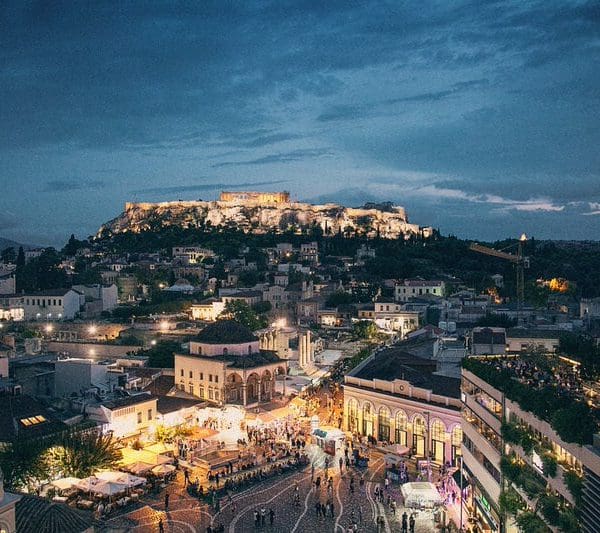Both historic and modern, edgy and traditional, Athens is famous as the capital of the Ancient world. Here you’ll find iconic structures like the Parthenon, the Acropolis and the Temple of Poseidon, but also a wealth of great coffee houses, delicious restaurants and buzzing bar scene. This is a truly young city, with a big student population – and the vibrant atmosphere that comes with it.
Here you’ll find iconic structures like the Parthenon, the Acropolis and the Temple of Poseidon, but also a wealth of great coffee houses, delicious cuisine and buzzing bar scene. This is a truly young city, with a big student population – and the vibrant atmosphere that comes with it.
Location: The Greek capital lies to the southern end of the mainland but in the central part of the country as a whole.
Language: Greek
Population of city: 665,000
Nearest airport: Athens International Airport
Main train/bus station(s): Athens Railway Station and Kifissos Bus Terminal (KTEL Kifisou)
Best time to visit? Mid-April to early-June or September to mid-October to avoid the hottest days and waves of summer tourists.
Budget level? ££
Best for: History & Museums, Landmarks, Arty
You could easily spend 3 or 4 nights here to see most of the city’s main attractions, but with plenty of gorgeous beaches just nearby, we couldn’t blame you for staying a full week!

The ancient Acropolis citadel is a breath-taking structure, sitting high above the city, containing the remains of several ancient buildings. The most famous building at the acropolis has the be the Parthenon, a stunning temple dedicated to the goddess Athena, dating back to 432 BC. Evidence suggest that this citadel was inhabited as early as the 4th century BC, and is now a UNESCO World Heritage Site and the most popular tourist site in Greece.
Translating to “Constitutional Square”, Syntagma is the central point of Athens both geographically and culturally. Overlooking the square is the Greek parliament building, at the foot of which is the tomb to the unknown soldier, a monument dedicated to all Greek soldiers who have died fighting for their country. This is the site of the changing of the guards, which takes place every couple of hours, drawing in crowds (largely down to the striking outfits and interesting walking style of the national guards). Syntagma is also the main transport hub of the city, and the metro station itself is worth visiting for the archaeological exhibitions in the station.
Located just a stone’s throw from both the Acropolis and Syntagma square, the Temple of Zeus is surely a sight to behold. Built in the 600s BC, this temple was one of the largest temples in Greece. It was originally made up of over 100 stone pillars, each measuring at 17 metres high, and 15 of which still stand today. The statues of various Greek gods inside were considered one of the Seven Wonders of the Ancient World, and still draw in the crowds to this day.
Previously the cultural hub of Athens, the Ancient Agora is a hotspot for history, culture and taking those all-important holiday snaps. Essentially the Syntagma square of yesteryear, the Agora was the central focal point of the ancient city, being home to a marketplace, amphitheatres, and several impressive temples. The most impressive of these being the Temple of Hephaestus, a stunning temple dating back to 450 BC.
Here, you’ll find the city’s old town, peppered with narrow and winding streets leading up the Acropolis. Taking a stroll around you’ll be sure to find some architectural wonders – or if you want more history, you can always pop into one of its many museums.
This is the most elegant and polished part of town, nestled away beneath Lycabettus Mountain. Designer boutiques, art galleries and the coolest cafes and clubs are the mainstays of this celebrity-frequented area, so be prepared for a slight price rise compared to other parts of town!
The museum district of Athens and popular with students, this is where to get your culture fix. You could easily spend a whole day exploring here, and follow it up with dinner and drinks at one of its laidback lounges.
A hub of cultural sites, this area was once heavily industrialised. Now the district has a younger vibe, and former factories house an array of museums and exhibition venues, as well as a good number of bars and clubs.
One of the oldest districts in the city, this is definitely one for a good-weather day! With numerous al fresco café courtyards and an open-air cinema, it’s ideal for spending long and balmy summer days and nights.
Athens’ National Archaeological Museum contains some of the most famous and unique artifacts excavated from all over Greece. Home to some of the most famous sculptures and pieces of artwork, such as the mask of Agamemnon, or the statue of Poseidon or Zeus (a topic still disputed amongst archaeologists), the museum boasts over 11,000 exhibitions, dating back to Greece’s Neolithic period. This is a must see for any history buffs and a key site in Greek history and culture.
Built by Antonis Benakis in 1930s as a tribute to his father Emmanuel, this museum is a go-to for all things art. A variety of Classical Greek artifacts and artworks are displayed in this awe-inspiring museum. With displays ranging from the Bronze Age to the Second World War, this museum ticks every box throughout Greek history.
An industrial museum doubled up as one of Athens’ most lively cultural venues. Originally built as a gasworks, Technopolis was converted in the late 90s into a hub for Athens’ music and arts scene. Today it hosts everything from live music to craft fairs, most of which is free and accessible for people of all ages and backgrounds.